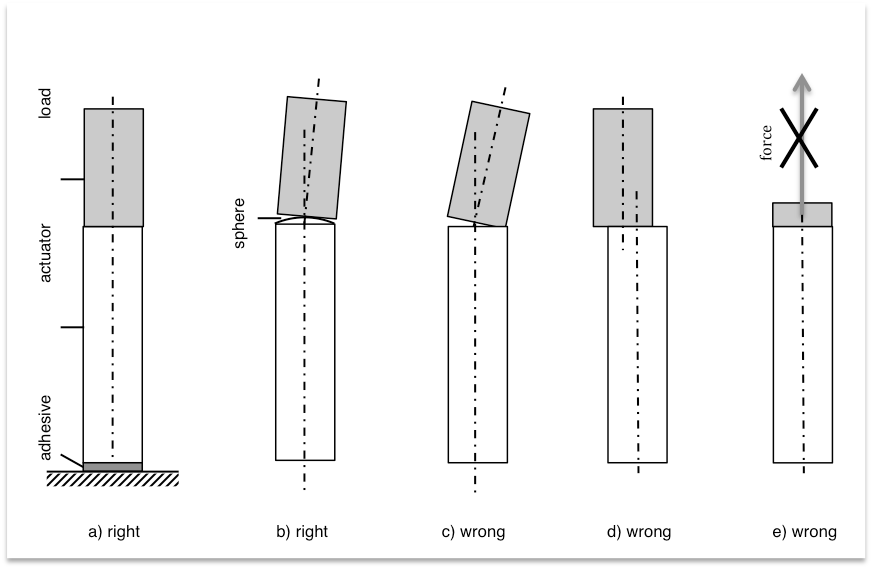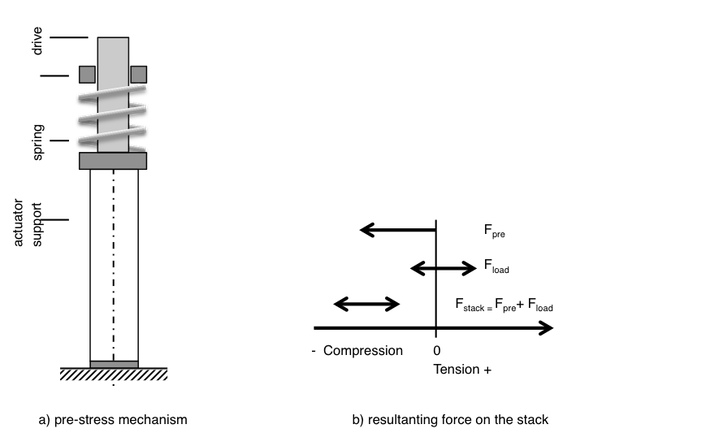Piezo Actuator Stack Installation and Handling Recommendations
Piezoelectric stacks are designed to generate uniaxial displacement. This is a prerequisite for long life and best performance with regard to strong, fast and precise actuation. The best performance and life of the actuator will be achieved when a pre-stress mechanism is installed. The ideal pre-stress mechanism provides a constant compressive force to the piezo stack. Compression is effective against mechanical damage e.g. cracking. Pre-stress data are recommended for Piezotechnics stack products.
It is important to accurately align load and actuator axis. Misalignment cause bending or shear forces in he actuator for which it is not designed. Align the actuator and the load axis precisely, so that the centre axis of the piezo stack as well as the axis of displacement is vertical to the mounting surface. Avoid any tensile forces on the stack during installation and operation. Ceramics are sensitive to tensile forces whereas they are vey robust with regard to aligned compressive stress. For structural applications e.g. attaching piezo stacks to composite structures for integrated actuation or sensing please contact Piezotechnik. Piezotechnik has comprehensive experience in those applications.
The chapter is a very practical one for proper designing the stack application and to avoid some problems.

The above figure explains the mechanical integration of a bare piezo stacks actuator. The load axis is aligned with that of the load and the stack is fixed with a thin layer of adhesive (figure a). Minor deviations of load and actuator are acceptable. The end faces of the base plate as well as the load face shall be plane. Any punctual load would cause high stresses and could cause cracks and subsequent failure. A spherical end piece can compensate slight misalignment of stack and load axis (figure b). The tilt of the load must be avoided (figure c). Partial coverage of load and stack end faces will lead to nonhomogeneous stress distribution in the stack and may lead to failure (d). Tensile forces have to be avoided (e). Also consider inertial forces in dynamic operation (e).

The actuator can be clamped or bonded to the load mechanism. Epoxy-based adhesives are recommended for bonding. Do not apply adhesives to the sides of the stack. Plane faces with full coverage of the end face of the stack are good practice. A plane drive piece could be used for mechanical interface (b).

A preferred method to provide sufficient pre-stress is shown in the above figure (a). A spring is mounted between a support and the drive piece and compresses the stack. The pre-stress arrangement allows safe and reliable operation. Applying a bias of compressive stress on the stack is a proper solution to handle tensile load forces. In above figure (b) the superposition of pre-stress Fpre and load force Fload with the resulting force Fstack on the stack is shown. Choose the right pre-stress level to meet with the maximum tensile force! The resulting force on the stack should always be in compressive direction.
Performance made of Passion.
Piezotechnics by
Piezotechnics GmbH
Germany
